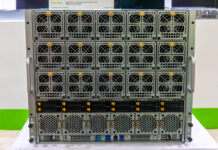Supermicro AS-1013S-MTR Power Consumption
Although the dual AMD EPYC designs can offer a lot of performance, they do so while surprisingly sipping power. We swapped the system into rackmount mode and put it in our data center using 208V 30A Schneider Electric APC PDUs. We measured power using the AMD EPYC 7401P, 128GB of RAM, and dual SSDs/ HDDs, and saw some great figures:
- Idle: 77W
- 70% Load: 211W
- 100% Load: 241W
- Peak: 274W
If you are comparing this to a dual-socket Intel Xeon E5-2650 V4 system, you will have lower power consumption and only need a single socket. The Supermicro AS-1013S-MTR has lower power consumption than any other single socket AMD EPYC server we have tested. That lowers operating costs and helps service providers maximize rack density.
Note these results were taken using a 208V Schneider Electric / APC PDU at 17.8C and 71% RH. Our testing window shown here had a +/- 0.3C and +/- 2% RH variance. The figures are certainly more than the Intel Xeon Silver line, but with that extra power consumption, AMD is delivering a more expandable platform and more performance.
Final Words
The Supermicro AS-1013S-MTR is an awesome machine if you are in the dedicated hosting business. You can provide your customers with more cores and more performance for less upfront cost than Intel Xeon, using AMD EPYC 7000 series “P” parts in 16, 24, and 32 core increments. Likewise, you get 8x DDR4 DIMM channels so you can create customer environments with not just high-performance compute, but also memory configurations up to 1TB.
In terms of serviceability, the ATX motherboard is easy to replace and there are plenty of options in the most common form factor. It took us under 7 minutes to fully populate the Supermicro AS-1013S-MTR DIMM slots, CPU socket, and four drives. For companies looking to maximize deployment velocity, this platform is perhaps the best in the business.
If you simply want the most expandable single socket AMD EPYC 7000 series platform, Supermicro has other options available. If you run a dedicated server business this is the single socket platform that is built for high performance, great TCO, and deployment velocity.
Here is a link to the product page.




The model seems much too simplistic, given the number of PCIe channels available from the “P” series EPYC CPUs, I would have expected 10Gbe LAN connections to be standard. As well as options/models with 2×2.5″ NMVe + 8×2.5″ SATA/SAS as well as 10×2.5″ NMVe drive bays to be available for single CPUs (Instead of Supermicro only making those options/variations available as dual CPU systems).
BinkyTO I get where the review is coming from though. This is like $3600 USD for the barebones, a 24 core chip and 128gb of ram. Add another $1000 for drives and for $4600 USD you’ve got a system we can lease for $750 day in and day out. Even with hosting costs you’d get payback in a few quarters. I don’t think it’s great if you aren’t selling dedicates but for us this is what we’ve been waiting for.
@BinkyTo
The motherboard makers must have good reasons to make all the cool-boards for an other brand of CPU.
It’s not just Supermicro, it’s all of them. 128 PCIe-lanes and nobody is using its real potential, makes you wonder…
@BinkyTo @Misha Engel:
Here pushing single AMD EPYC to the limit.
https://www.tyan.com/Barebones_GA88B8021_B8021G88V2HR-2T-N
@Jay C,
Supermicro already has 1U model with the storage setups I am looking for, but they require dual EPYC CPUs — when a single EPYC has the same number of PCIe lanes as a dual CPU setup. So there is no reason to require dual CPUs.
@Misha,
These are the same mobo manufacturers that create 31 mobo’s when the Intel Skylake CPUs or when Intel released were released. Never mind the number of mobos required to support the latest “CxxxxxxFxxk” of Bronze, Silver, Gold and Platinum Intel XEON CPUs… especially, when they have a 1U chassis which supports dual EPIC CPUs already listed/available.
From the comments in the review it is not easy to understand if the 16 sata3 ports in the motherboard are functional or Supermicro included a special version of the motherboard with reduced specs. Any of you can help me with that doubt? I’m looking to buy one of these and it will be my first supermicro system.
Thanks